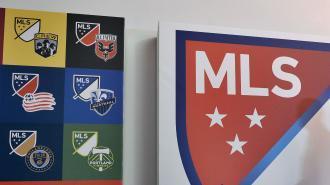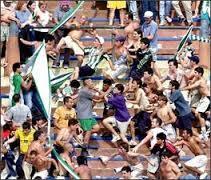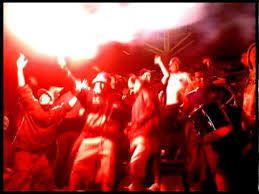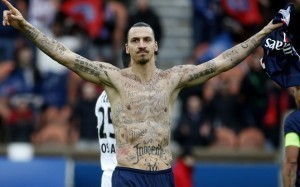Laurent Dubois's Blog, page 71
March 17, 2015
Thoughts on Latin American Soccer
One clip of Latin American soccer and you know that they are infamous for their relentless passion for the sport. From the sonorous vuvuzela sound that rings through the stadiums to the 30-second long “goooal” chants after each score, no culture is more upfront about their soccer obsession than Latin Americans. And all the love and craving for this sport is justified. While I always knew of the cultural interests these countries possess, after the readings about the development of Latin American soccer, I have learned that these countries have produced some of the best players, most nail-biting matches, and biggest drama.
Almost every country has contributed in some way to the soccer politics of the globe, the major ones being Brazil, Mexico, Argentina, Cuba, Peru, and Venezuela.
From class discussions and readings, it seems as if some people are so devoted to soccer, they treat it as a religion. Eduardo Galeano states that, “There are towns and villages in Brazil which have no church, but not a one lacks a soccer field.” In class, we were introduced to “Iglesia Maradonia,” or the Church of Maradona, which has its own 10 Commandments and worships every aspect of this player. While Diego Maradona of Argentina brought great joy to the field and fans through his four world cups her participated in, he brought something more that highlights the passion of Latin Americans in relation to football. Through his actions related to soccer, drug habits, and more, Maradona transformed the role that a soccer player can have on his or her country. For Argentina during his prime, Maradona developed a political purpose in his outspoken opinions on imperialism, a road less travelled by athletes a that time. Sporting tattoos of Fidel Castro and Che Guevara, Maradona and his political antics stand out amongst the sea of timeless athletes.
These readings on Latin America shed light on other soccer superstars, such as Pele and Garrincha. These two timeless athletes played for Brazil at the same time, and Brazil never lost a match under their watch. While these two players flourished on the pitch, their life off the pitch could not be more different, a story detailed by Goldblatt in his book.
Latin American countries always hold a strong presence at every World Cup. For example, in 1978, the 11th World Cup, the Argentine dictatorship hosted it, as well as won it. Argentina had recently suffered a military coup led by the National Reorganization Process. Near the Buenos Aires Monumental Stadium, “Argentina’s Auschwitz, the torture and extermination camp at the Navy School of Mechanics, was operating at full speed.” The close juxtaposition of these harsh conditions and a world-wide event was basically ignored. The denial in addition to the win put Argentina in a fine light that masked the true hardships people were enduring through the Argentine dictatorship.
This instances are just a few of a plethora of political instances involved with Latin American soccer. They add on to the culture behind Latin American soccer and justify the deep passion these people hold for the sport.
March 16, 2015
Fútbol en el Cotton Bowl

http://en.wikipedia.org/wiki/Fair_Park
En la semana antes de las vacaciones de primavera, leímos el texto de Gaffney, Temples of the Earthbound Gods, que discute el papel de estadios en el desarrollo e identidad de ciudades sudamericanas. Durante la discusión, reflexionamos sobre nuestras experiencias en estadios, y me gustaría compartir una anécdota sobre un partido de fútbol que vi el verano pasado.
Después de la Copa Mundial, muchos equipos europeos hicieron una gira internacional. Real Madrid y Roma vinieron a Dallas, mi ciudad de residencia. Había estudiado en Madrid el año pasado, por lo tanto estaba muy emocionada para apoyar Real Madrid. Fui al partido con tres amigas. De hecho, una de ellas había sido mi compañera de cuarto en Madrid.
En vez de usar el estadio de FC Dallas, el partido ocurrió en el Cotton Bowl, un viejo estadio de fútbol americano. El Cotton Bowl es un símbolo de identidad tejana y es muy importante durante La Feria Estatal de Tejas. El Cotton Bowl es más conocido por ser el campo neutral para el “Red-River Rivalry”. Cada otoño, hay un partido de fútbol americano entre The University of Texas y The University of Oklahoma.

http://blog.tiqiq.com/2014/12/early-l...
El partido de Real Madrid y Roma empezó bien, y todos los espectadores estaban animando a sus equipos. Todo cambió durante el minuto 87. De repente, un hombre saltó sobre las barreras y corrió a través de la cancha. Inspiradas por este acto de valentía, otras personas comenzaron a copiarlo. La policía no sabía que hacer. Algunos oficiales persiguieron a los hinchas, pero no pudieron capturarlos. Otros trataron de bloquear las barreras, pero eso no funcionó tampoco; los hinchas seguían saltando y corriendo en la cancha. Algunos padres levantaron sus hijos sobre las barreras para que ellos pudieran correr en la cancha y sacar fotos con los jugadores. Eventualmente, los jugadores se sentaron en la cancha hasta que los espectadores pararon en interrumpir el partido. Finalmente, el partido continuó y los árbitros añadieron cinco minutos extras.
Yo estaba humillada. Esto nunca pasaría en Europa. Los hinchas demostraron una falta de respeto a los jugadores, el partido y el deporte. La policía falló en sus responsabilidades de guardar la cancha.
Después del partido, busqué razones para explicar el comportamiento de estas personas. Quizás es porque el fútbol no es el deporte principal en los Estados Unidos. Quizás es porque la Copa Mundial había acabado de terminar. Quizás es porque estas personas son más leales a otros equipos de fútbol.
Después de leer el texto de Gaffney, tengo otra teoría. Quizás el estadio contribuyó a los eventos. Es un estadio viejo, el tipo donde es aceptable dejar su basura debajo del asiento. No crea el sentimiento de estar en un estadio sagrado. Por lo tanto, los espectadores van a actuar más impulsivamente. Adicionalmente, todo el mundo relaciona el espacio con el fútbol americano. No es un estadio de soccer, y quizás los hinchas no piensan que las normas de soccer existan en el estadio. Finalmente, los asientos más cerca a la cancha no son muy elevados. Esto quita la separación física y mental entre los espectadores y los jugadores.
Tristemente, Real Madrid perdió el partido, pero se pierde este detalle en los otros eventos de la noche. En conjunto, estoy agradecida que podía ver el partido. Aunque no tengo un “selfie” con los jugadores como este hombre, tenía una experiencia que nunca olvidaré.

http://soccerblog.dallasnews.com/2014...
The World Cup and the Dirty War
In 1978, Argentina hosted the World Cup in the midst of a period of tremendous political repression. Grant Farred’s book Long Distance Love tells this story, and reflects on what it means for the way we think about politics and football. More recently, this 2014 piece by Wright Thompson offers a remarkable account of the co-existence of the World Cup & torture, with a number of testimonies by victims.
March 15, 2015
Influx of foreign players into Major League Soccer
With the start of the 2015 Major League Soccer (MLS) season and the newly signed Collective Bargaining Agreement, there are many notable things going on for soccer in the United States. Specifically, it is important to note the increasing presence of foreign soccer stars playing in the MLS. Now more than ever before, foreign players are scattered throughout the league, from Kaka’s debut with Orlando City FC and David Villa’s arrival with New York City FC, to the future introductions of Frank Lampard with New York City FC and Steven Gerrard with Los Angeles Galaxy. Aside from these players already playing or contractually scheduled to play at some point in the current MLS season, numerous other foreign players have also expressed interest the league. So what’s going on here? Why has MLS suddenly become so attractive to foreign players? And what else needs to happen in order to make MLS one of the best soccer leagues in the world?

New foreign MLS players, from left to right: Frank Lampard, Kaka, Sebastian Giovinco, David Villa, and Steven Gerrard. Source: http://twicsy.com/i/nBEeKh
After Kaka’s first game with Orlando City FC, in which he scored the tying goal, he stated that:
“A lot of players are looking for this league now. [In] five, ten years it will be one of the biggest in the world.”
Some of the major reasons for player attraction towards the MLS include the lifestyle (where stars are not mobbed by fans everywhere they go), the increasing level of play in the league, and the increasing amount of money available (where the top players in MLS have salaries that are comparable to other salaries from European leagues).
The league is growing in size and wealth and the presence of these foreign stars is certainly part of the reason why. The infographic below shows the steady growth of interest and viewership of MLS fans.
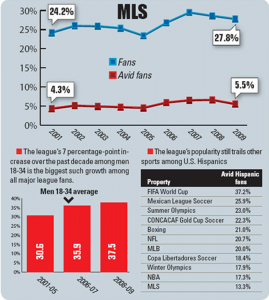
Rising interest in Major League Soccer amongst different types of fans. Source: http://assets.sbnation.com/assets/339...
In an interview with MLS commissioner Don Garber, he discussed the recent influx of high profile foreign players and how the league has been strategizing for and managing its growth in size in popularity and wealth. He commented about the future steps needed to make the league one of the best in the world:
“player salaries and budgets are only one aspect of what makes the top leagues great. It’s the quality of play, and that’s not just in what players’ earn, it’s also investment in academies, and an infrastructure. You combine that with the out-of-budget investment we’re making, both on the youth side and the designated player side, and then you add terrific stadiums and passionate fans. And you connect all those dots, I believe that will make us one of the world’s best.”
It’s definitely a good sign that MLS is investing in American soccer and building the league from the ground up. Perhaps we are all currently witnessing the start of something great for American soccer and MLS.
Isco: A Sleeper Awakens
 In early 2015, Real Madrid has struggled, between a stream of injuries, an underperforming Gareth Bale, and inconsistent, poor play. However one player has stepped up, Isco, number 23 is a player that most would not consider a superstar, but one who has been crucial in helping a struggling Madrid stay afloat, making up for an injured James Rodriguez and Luka Modric. In his time filling in as a starter on Madrid Isco has played a beautiful game, creating wonderful opportunities for his teammates, making perfect passes, and defeating difficult challenges.
In early 2015, Real Madrid has struggled, between a stream of injuries, an underperforming Gareth Bale, and inconsistent, poor play. However one player has stepped up, Isco, number 23 is a player that most would not consider a superstar, but one who has been crucial in helping a struggling Madrid stay afloat, making up for an injured James Rodriguez and Luka Modric. In his time filling in as a starter on Madrid Isco has played a beautiful game, creating wonderful opportunities for his teammates, making perfect passes, and defeating difficult challenges.
Although he is not a complete no-name player, Isco still tends to be a bit of a sleeper and has always seemed to be just barely out of the spotlight, passed up for awards and overshadowed by several of his peers such as James Rodriguez, Gareth Bale, and Cristiano Ronaldo. Additionally he was cut from the 2014 Spanish national football team, and was bypassed for beIN’s “25 Under 25” best soccer players list. However his stats speak for themselves, despite only playing 19 matches this season, Isco has the 5th most assists this season behind only Messi, Ronaldo, Cheryshev, and Suarez. Iker Casillas, Real Madrid’s captain, and renowned Spanish goalkeeper once commented that “Isco is the most important Spanish player of the future.” Its true that Real Madrid has many great players that could start over Isco, however he has proved this season that he is an incredible player, and that with more development (and more playing time) he could prove to be more than just an important Spanish player in the future, he could be an incredibly important Real Madrid player in the future.
MLS’s New CBA – Baby Steps
Earlier this month, much hubbub was made that the Major League Soccer Players Union had yet to reach an agreement with the MLS regarding the new collective bargaining agreement (CBA). Up until the third day of negotiations on March 4th, the players were still maintaining their demand of free agency. It seemed that the games that were set to begin later that week on Friday, March 6th were doomed to be delayed. However, early Thursday morning on March 4th, it was revealed that the Players Union and MLS had indeed reached a framework of an agreement.
The High Points
Free agency was granted to the players of MLS… with some major caveats. As ESPN FC reported,
“Players 28 years of age or older, and with at least eight years service in the league — not necessarily with the same team — will be eligible for free agency. While there are no limits to the raise that their existing team can give them, the raise that other teams can offer is limited based on the player’s current salary. Players making under $100,000 can receive a 25 percent raise, players earning between $100,000 and $200,000 can receive a 20 percent raise, while those making over $200,00 will be limited to a 15 percent raise.”
Other concessions were made such as the 7 percent annual increase on the salary cap and an increase in the minimum salary to $60,000 per year were significant gains made by the Players Union. The minimum salary gains, in particular, represented a near doubling of the previous minimum of $36,500. The new CBA will last for 5 years, allowing for bargaining talks to continue once again in 2020.
Reactions
By and large the reactions to the new CBA were positive, with owners and fans breathing a collective (pun intended) sigh of relief that the games would be played as scheduled. The players, on the other hand, were disappointed as their demands were not fully met.
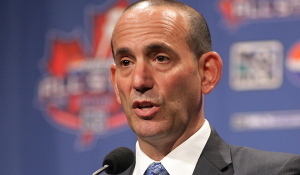
Don Garber has served as the League Commissioner of the MLS since 1999.
Don Garber, league commissioner of the MLS, felt positively about the new agreement:
“This agreement will provide a platform for our players, ownership and management to work together to help build Major League Soccer into one of the great soccer leagues in the world,” commissioner Don Garber said in a statement.”
The executive director of the MLS Players Union, Bob Foose, also applauded the new CBA:
“We are pleased to announce that we have reached a new Collective Bargaining Agreement with the league. We are pleased to finally turn our fans attention back to our players and the competition on the field as we get started on the 2015 season.”
Some have questioned if Foose pushed hard enough for the demands of the players, but he remains the stance that he was able to get the best deal from the MLS. The best deal may not have been the ideal deal, but it was better than any other offer that was on the table.
However, other stakeholders were not nearly as positive. One veteran player, who elected to remain anonymous, had these remarks about the new CBA:
“An absolute disgrace. We have been talking about this for over a year, staying united and this what we came up with? We caved in under pressure. Some of the guys at the negotiating table had personal agendas. Granted, some of those issues would not necessarily benefit us older players, but it will have been huge for the sport in this country. It would have benefited future MLSers and the current young player. But instead, we failed miserably once again.”
Perspectives
The modified free agency represents a concession of the owners to satisfy the players, but it does not nearly come close to the players’ original visions and demands for free agency. Firstly, the “free agency” is limited to veterans of the league of over 28 years with 8 years of play in the league. While this is an improvement to the original 32 years of age required for free agency, the limit still imposes a restriction on the “open market” that the players demanded. Furthermore, free agency in the MLS will not allow competing teams to offer as much money to a player as his original team. If a player were to outperform their contract and demand a raise, the original team would not be forced to pay a significantly greater raise than what the market could offer him, which is blatantly capped. Thus, the new free agency is actually a capped restrictive free agency only available to veterans.
Though the players may be upset that they were not granted unrestricted free agency, the fact is that the players were able to make significant strides in the minimum salary of other players. Furthermore, complete free agency was more indicative of a revolutionary CBA rather than an evolutionary one, as was the one that finally was agreed upon. At this stage of the growth of MLS, the players simply do not have enough leverage to demand completely open free agency, however, they can look to the minimum wage increases as a significant step in the right direction as their eternal compromise with MLS owners continues in 2020.
The Barrabrava – Crusaders Turning Exploiters
As I read Christopher Gaffney’s Temples of the Earthbound Gods, one issue that particularly struck me was the excessive nature of the barrabrava, the fierce fan group that exists in most of the Argentine and South American football clubs. In the book, Gaffney suggests the unclear, shady relationships between the clubs and their barrabravas, or barras in short, and some of the borderline illegal actions that the barras take that is veiled under the name of passion and footballing identity.
For instance, the level of physical violence that the barras have reached a point where the barras of each club have their signature means of violence – rubber mallets in San Lorenzo or umbrellas in Independiente, for example – and yet their clubs have remained reluctant, even sympathetic towards such acts. The barras also have developed a convention of “testing” the young prospective barras to steal or fight against the rival team barras before letting the kids join their group. These codes and acts that the barras loyally uphold seem equivalent to hazing in a college fraternity group, which we consider as a social problem here in the United States.
Image from: http://barras-bravas-peru.blogspot.com/
And yet Gaffney does not see the barras as such; rather, he regards them as a representation of the Argentine society, in which social divisions and deterioration are met with a lack of worldwide attention. For a nation that has been full of suppression and dictatorship, the football stadiums are the only places where Argentine people can have an expression, as Gaffney states in his book:
“Although no one would assert that ritualized stadium violence is an acceptable societal norm, there is little mention in the daily press that this violence is a product of socioeconomic and political marginality… This implies a toleration of violence within certain bounds that recognizes the “need” for social expression of this kind.”
This gives an impression that the barrabravas are regarded among the Argentine people as something of a crusader of such socioeconomic expressions desperately needed throughout the entire Argentine people. The barras themselves certainly regard themselves as such, as Gaffney depicts them to regard themselves as “forced” in a position to act violently, as if they are protesting against the social framework of their mother nation. What concerns me, however, is that the lack of connection between the actions of the barras and the context of their actions – the very thing that is keeping their status as the crusaders – may also be turning them into exploiters. Already there have been signs of corruption within the barrabrava hierarchies, including bribery towards their supporting clubs, illegal drug trafficking, and other actions that are lesser relevant to the social undertones that the barras are supposed to express. These, I believe, reflect that the social context of such violent actions are not being transcended to the younger generations, and I believe that the lack of attention of such context from the media is one of the factors that are causing such spiritual corrosion among the barras.
Image from: https://www.youtube.com/watch?v=GdPwF...
Of course, it may be difficult at this point for the Argentine media to focus the barrabravas and their function as an outlet of social and economic opinions to the public; a long era of dictatorship is bound to leave an air of reluctance among individuals to express controversial opinions, as I experienced back in my home country, South Korea. However, as the barras themselves seem to gradually lose their spirit behind their acts of violence, it would be the job of the media to remind the barras of their roots – a crusader, not an exploiter.
Gaffney, C. (2008). Temples of the earthbound gods stadiums in the cultural landscapes of Rio de Janeiro and Buenos Aires. Austin: University of Texas Press
“Violence, Power, Soccer and Drugs: Argentina’s Barras Bravas”
http://www.insightcrime.org/news-anal...
Fetured Image from:
March 13, 2015
Grant Wahl: segundo álbum Panini y primer juego de fantasía para la WWC 2015
A menos de 3 meses del inicio de la Copa Mundial de Fútbol Femenino (WWC por sus siglas en inglés) Canadá 2015, los equipos se siguen preparando. Estados Unidos, No. 2 a nivel mundial, se vengó de la derrota que sufrió ante Francia, No. 3, en el amistoso que disputaron en Lorient el pasado 8 de febrero, y le arrebató la Copa Algarve al ganarle 2-0 en la final este miércoles. Un día después, Inglaterra, No. 6, conquistó la Copa de Chipre, al vencer en la final a la anfitriona del Mundial, No. 9, por 1-0.
Por otro lado, Grant Wahl–quizás el periodista deportivo que escribe sobre fútbol más famoso en EEUU y uno de los invitados a nuestro simposio sobre la WWC en abril–acaba de publicar un artículo en Sports Illustrated con dos noticias de una relevancia inconmensurable para el fútbol femenino.
En primer lugar, las y los fans del célebre álbum Panini podrán coleccionar e intercambiar stickers de las jugadoras que participarán en el Mundial de Fútbol Femenino este año como ya lo hicieron para Alemania 2011. A pesar de que en un comienzo Jennifer Paredes, Coordinadora de ventas online de Panini, dijo que la empresa no pensaba vender álbumes para la WWC este año (ver imagen de su tweet debajo), uno de los directores del Grupo Panini, Peter Warsop, se encargó de desmentir esta posibilidad.
Warsop indicó a The Equalizer que, a pesar de que el fútbol femenino no tenga un atractivo comercial masivo, Panini lanzará al mercado su álbum para la WWC una vez que consiga el permiso de todas las selecciones pues el grupo “siente la responsabilidad de contribuir para construir una nueva tendencia”.
Por otra parte, Mondogoal, una plataforma de juegos deportivos de fantasía, ha anunciado una versión diaria de un juego para la Copa Mundial de fútbol femenino, el cual sería el primero para un deporte femenino.
Tal como lo explica Wahl, quien quiera usar la plataforma para la WWC, escogerá un equipo de 11 jugadoras de las selecciones nacionales en un día determinado. Estas jugadoras de fantasía ganarán puntos a partir de su performance en los partidos de la vida real. Al final, quien acumule más puntos puede canjearlos por dinero (un detalle que, según Shergul Arshad, Presidente Ejecutivo de Mondogoal, puede atraer una mayor cantidad de público tanto masculino como femenino) o se puede jugar solamente por diversión.
(Ejemplo de una formación de la Premier en Mondogoal)
Aquí dejo un link, en inglés, por si alguno o alguna de ustedes está interesado(a) en aprender a usar Mondogoal antes de la WWC.
Wahl concluye su artículo con una pregunta que parece ser un guiño a nuestro curso: “¿Cuán lejos estamos, después de todo, de que aparezcan equipos femeninos por primera vez en el popularísimo videojuego EA Sports FIFA?
 (La selección alemana de fútbol femenino buscará recuperar la corona mundial en Canadá 2015. Foto: Reuters)
(La selección alemana de fútbol femenino buscará recuperar la corona mundial en Canadá 2015. Foto: Reuters)
March 10, 2015
Tattoo Activism
Tattoos are a prominent part in todays game of football. Whether they be works of art, religious allegiances, meaningful messages or propaganda, each star has the opportunity to showcase them to millions of viewers. In this piece I’m going to shed light on some of the more iconic pieces in today’s game, and how they have been used to the benefit of others.
Zlatan Ibrahimovic
Zlatan is perhaps the most inked icon in the footballing world. His latest undergoing was the addition of 50 names to his frontal region. On the surface this seems very odd and unorthodox, but that’s who Zlatan is. The names were to signify the UN World food Program and the whom suffer from hunger. The 50 names were only scratching the surface for the most problematic “disease” in the world, hunger. Zlatan revealed the new creation after his second minute goal against Caen. Such an act was deemed irresponsible, as removing one’s shirt so early in a game and garnering a yellow card puts the player and the team at risk for the remaining minutes. However, for Zlatan, disclosing the message was far more paramount than the cautionary punishment. In a WFP he exclaimed; “whenever you hear my name, you will think of their names. Whenever you see me, you will see them”. Zlatan’s tattoo was also complimented by a promo-awareness clip that attained 1.2 million hits by the end of the unveiling weekend. Today, that number is relishing in the upper 4 millions.
Tim Howard
Tim is another decorated activist, to an extent. On the surface, you would never know as his collection is hidden from plain sight. Meanwhile under his shirt he has a mosaic of images and names. For Tim, family seems to be the most integral part of his work and he bears his child’s name Jacob on his right pectoral and a juvenile image of his mother on his right. However unlike Zlatan, Tim doesn’t parade any activist pieces, as taking a shirt off is an infrequent part of a goalies‘ game. Rather, Tim models for groups to highlight his backing. Recently he unveiled his torso for PETA and their “Ink, NOT MINK” campaign. PETA is a meaningful charity, to Tim, as he despises the inhumanity toward the animals whom are embroiled in the fur trade. It was this sentiment that inspired him to raise awareness of the cruelty, and hopefully make a difference.
Both of these players are national football hero’s in their respective countries. By portraying their allegiances to these worthy causes, it really inspires the younger generations too also“make a difference”. The youth look up to these players and want to become just like them. A humbling act will be viewed upon by some as a necessary act to not only please their hero but to also make it to the top level. A simple stand can go a million miles. The other aspect is the fact that these two garner so much media attention that by becoming activists the will spread their charities‘ manifesto all over the world. This would be faster than they or the charity could’ve managed alone, with the medias outreach. Zlatan and Tim are two humble players who are looking to make a difference on and off the pitch.
March 9, 2015
Respuesta al libro de Gaffney
El argumento principal del libro de Gaffney es que los estadios son aspectos importantes de todos los sociedades y culturas del mundo. Los estadios nos impresionan porque son espacios donde se puede compartir emociones al mismo tiempo en el mismo lugar. Además, destaca el hecho que los juegos que ocurren en los estadios a menudo son espectáculos y les dan a los espectadores un sentido de “participación privilegiada” (Gaffney, 46). La capacidad de decir “yo era allí cuando este equipo ganó este juego” o algo así es un motivo de orgullo único. Hay varios distintos fines para los cuales se utilizan los estadios en Latinoamérica. Son monumentos y “repositorios de la memoria colectiva”, y evocan los valores asociados con eventos y personas específicos en una manera que otros tipos de monumentos no pueden. Gaffney posiciona su discusión de la importancia de los estadios latinoamericanos en el contexto de los espacios públicos y el discurso de los sociedades que se juntan en largas plazas, mercados, y otros sitios. En el periodo del desarrollo que empezó al comienzo del siglo 20, los elites querían imponer un mayor nivel de “civilización” (es decir, control) en los espacios públicos como parte de su plan de construir ciudades modernas como las de Europa. Me parece fascinante la observación de Gaffney que, en ciudades largas como Rio de Janeiro y Buenos Aires, los estadios funcionaron inicialmente como símbolos de “sofisticación cosmopolitana y exclusión social” (Gaffney, 134). Esta idea contrasta fuertemente con mi concepto de los estadios, que hoy en día son lugares donde personas de cualquier clase social o fondo cultural puede reunir y participar en un actividad comuna. El hecho que empezaron como lugares para personas “especiales” (ricos) solamente me impresionaba mucho, y pienso que es importante reconocer esta historia cuando tratamos de comprender las políticas de futbol hoy en día.
Más generalmente, me sorprendió que la idea original para los estadios que asocio yo con el futbol latinoamericano fue tomada de los países Europeas y que eran, de una manera, herramientas de “civilización” en un parte del mundo “barbárica”. El año pasado, yo fui a un juego de Real Madrid en Santiago Bernabéu y el dinámico e emoción de los aficionados me dio la impresión de que el estadio era algo nativo y intrínseco a la cultura latinoamericana. Por esta razón, el análisis de Gaffney fue muy interesante e importante para mi comprensión del juego en general.
Laurent Dubois's Blog
- Laurent Dubois's profile
- 44 followers


